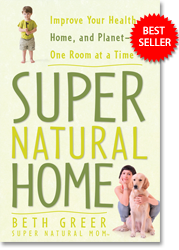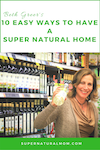By the time you walk out the door in the morning, after slathering, and spritzing yourself with toner, moisturizer, eye cream, foundation, blush, eye shadow, eyeliner, mascara, lipstick, gloss and perfume, you may have put enough chemicals onto your body to be hazardous to your health. Many of the chemicals in makeup have been linked to cancer, hormone imbalances and skin irritation.
According to the Environmental Working Group, a nonprofit environmental research organization, which conducted an assessment of more than 1,000 cosmetic brands, less than 1 percent are made from ingredients that have all been evaluated for safety. “Some products contain carcinogens, reproductive toxins and other chemicals that may pose health risks,” notes the group’s website.
The Food and Drug Administration does not review cosmetic ingredients for their safety before they come to market, nor does it have the authority to recall hazardous products.
“Women face daily and widespread exposure to hundreds of chemicals linked to breast cancer, and reducing — or even understanding — this environmental contamination might do as much as screening or treatment to reduce a woman’s risk of getting the cancer,” says a report in the journal Cancer by Susan G. Komen for the Cure and the Silent Spring Institute. (May 2007)
According to the Campaign for Safe Cosmetics, a program that helps raise awareness about cancer-causing chemicals in cosmetics, the average consumer (including teens) uses 15 to 25 cosmetic and personal-care products a day. These contain about 200 chemicals that have been added to preserve, dye and emulsify the products. Some are the same chemicals used in industrial manufacturing to soften plastics, clean equipment and stabilize pesticides.
One widely used group of synthetic chemicals, parabens, are used as antimicrobial preservatives in more than 13,000 cosmetic products. The Environmental Protection Agency states that all parabens — methyl, propyl, and butyl — have been proved to interfere with the function of the endocrine system, and these endocrine disruptors are stored in our body’s fatty tissues. The Center for Children’s Health and the Environment at Mount Sinai School of Medicine in New York says endocrine disruptors have been suspected of contributing to reproductive and developmental disorders, learning problems and immune system dysfunction in children.
This is especially alarming considering that young girls are starting to use cosmetics earlier and more often. According to a 2004 cosmetic industry report by market research firm Mintel International Group, 90 percent of 14-year-old girls say they use makeup. The survey revealed that 63 percent of 7- to 10-year-olds now wear lipstick; more than 2 in 5 girls in that same age group wear eye shadow or eyeliner, and almost 1 in 4 uses mascara.
The European Union recently passed a law banning the use of suspected CMRs — carcinogens, mutagens or reproductive toxins — in any cosmetics sold in the 25-member EU. The major U.S. cosmetics companies that sell abroad have to reformulate their products to conform to EU safety guidelines, but most haven’t changed the formulas they sell here. Avon, the self-proclaimed “company for women,” hasn’t yet signed the Compact for Safe Cosmetics, a pledge to remove carcinogens and other harmful ingredients from beauty products.
However, last September, bowing to pressure from environmental groups and European lawmakers, Orly International and OPI Products, two top beauty-salon brands, started selling reformulated nail polishes without the chemicals dibutyl phthalate (DBP, a plasticizing ingredient used to increase flexibility in nail polishes), formaldehyde and toluene, which have been linked to cancer and birth defects.
Health advocacy groups say that when it comes to chemicals that affect human health and the environment, better safe than sorry should be the guiding principle.
Reading labels won’t always help you avoid these chemicals because the beauty industry doesn’t always disclose every ingredient in its products. For example, phthalates are rarely mentioned on labels, so there’s no way to tell whether they’ve been used. Phthalates keep your mascara from running, stop your nail polish from chipping and help fragrances linger. There’s evidence that exposure to phthalates can harm the development of fetuses and children. According to the Breast Cancer Fund, hundreds of animal studies have shown that phthalates can damage the liver, kidneys, lungs and the reproductive system, primarily of male offspring.
Health Care Without Harm, an umbrella organization of dozens of environmental and health groups, lab-tested 72 cosmetics by major brands such as Revlon, Calvin Klein, Christian Dior and Procter & Gamble and found phthalates in 52 of their products. The best way to protect yourself is to read labels (use a magnifying glass if necessary!) and be suspicious: Words like “natural” or “hypoallergenic” look reassuring, but they’re basically meaningless. The FDA has no control over these labels. Products called “natural,” for instance, may include synthetic dyes and fragrances. “Hypoallergenic” just means that the most common irritants are left out, but other problematic chemicals might still be in the mix.
“Fragrance-free” or “unscented” means a product has no odor, but synthetic ingredients are often added to mask odors. Products without the word “fragrance” on their label should be OK. Cosmetics labeled “organic” must contain 70 percent or more organic ingredients (grown without the use of pesticides), but read the ingredient list carefully. It’s important to choose products from trusted cosmetic and body care companies that use natural, certified organic, nontoxic and non-synthetic ingredients.
Look for these companies in your local health food store, or online: Juice Beauty, Grateful Body, Max Green Alchemy (MGA), Dr. Hauschka, Jurlique, Iredale, PeaceKeeper Cause-metics, Gabriel, Zuzu, Burt’s Bees, Lavera and Pomega5.
While chemicals in any one product are unlikely to cause harm, here’s the bottom line: We are repeatedly exposed to synthetic chemicals from many sources each day. So even a small change, like switching to a nontoxic lipstick, might make a difference in your health.
According to the Safe Cosmetics Campaign, avoid the following chemicals in cosmetics whenever possible:
- Butyl acetate
- Butylated hydroxytoluene
- Coal tar
- Cocamide DEA/lauramide DEA
- Diazolidinyl urea
- Ethyl acetate
- Formaldehyde
- Parabens (methyl, ethyl, propyl and butyl)
- Petrolatum
- Phthalates
- Propylene glycol
- Sodium laureth/sodium laurel sulfate
- Talc
- Toluene
- Triethanolamine


